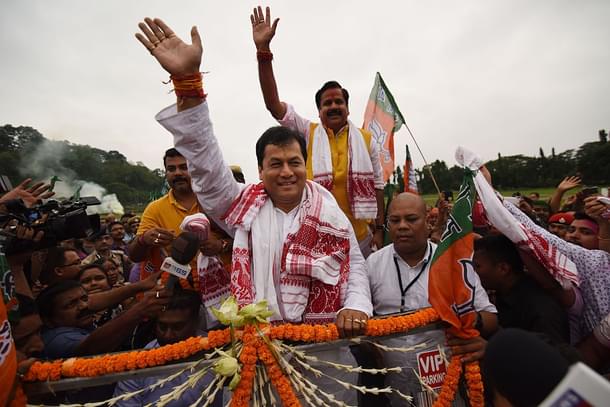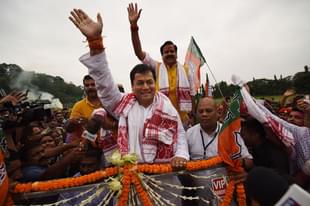Blogs
The Nationalisation Of The BJP, And Marginalisation Of The Congress
Vivek Misra
May 27, 2016, 02:21 PM | Updated 02:21 PM IST
Save & read from anywhere!
Bookmark stories for easy access on any device or the Swarajya app.


“Zindagi ko badalne mein Waqt nahi lagta
Par Waqt badalne mein Zindagi lag jati hai!”
Times have changed! The Indian political landscape and narrative have undergone a radical transformation ever since Modi brought BJP to victory in 2014. Delhi and Bihar notwithstanding, results from the latest assembly elections confirm the trend that started with the general elections in 2014 - of BJP slowly expanding its national footprint, the Congress dramatically losing vote share and regional parties emerging as principle opponents to the BJP. These three factors have completely changed the political landscape in the country.
Nationalisation of the BJP
Not so long ago the BJP was labelled as a Hindi-belt party, and the Congress prided itself on its pan-India presence. Today, it is a different story. With 13 states under its belt, the BJP’s footprint is now visible in all four corners of the country. What it needs to do now is to consolidate and build on its gains, particularly in areas like Kerala and West Bengal, while maintaining dominance in its traditional bastions.
It was virtually unimaginable in 2013 that this would happen.The Modi magic has not only brought the BJP to power at the centre, it has also ensured BJP’s spread to hitherto unchartered waters. Modi will, perhaps, go down as the foremost political figure in BJP’s history who took the party to the zenith of political dominance.
Regionalisation of the Opposition
The shifting of the centre of gravity towards BJP and the consequent weakening of the Congress effectively makes the regional parties the main challengers to BJP’s dominance. And there are quite a few. If Arvind Kejriwal was the giant killer a year ago, Nitish Kumar became the toast of the town six months ago, and now Mamata Banerjee is the flavor of the season. And we haven’t yet come to the forthcoming elections in UP.
What is clear is that the gradual weakening of the UPA (or what remains of it). DMK, NCP, IUML have stagnated. The Left’s dalliance with the Congress has been a disaster in Bengal. With the Congress no longer remaining the pole for opposition, regional parties will venture out to be lead players. Can they arrive at a common platform? Unlikely if we go by earlier evidence. But if Nitish could go with Lalu in Bihar and the Left with Congress in Bengal, anything is possible. Pursuit of power scores over ideology, especially when survival is at stake.
Marginalisation of the Congress
Perhaps the most trending news today is the marginalisation of the Congress. As if the decimation at the centre was not enough, it is slowly bleeding to death in the states. The real bad news for the Congress is the latter. First, in our federal polity, foothold in important states ensures relevance at the centre. The decreasing footprint of the Congress reduces its leverage at the national level, thereby allowing multiple regional players to fill that space. Second, lack of regional footprint reduces the ability of the party to perform electorally at the national level. It is indeed a vicious cycle that the Congress is likely to endure – decreasing leverage at national level will affect regional image and weak regional performance in turn will affect national electoral prospects.
This is also the reason that the Congress will find it difficult to fight back – it has not invested in local leadership. This will prove to be the fundamental factor for its bleak future. The culture of the Congress has revolved around the hegemony of the Gandhi family, which extracted more political (and financial) capital from states than it provided. It will take years before it is able to start cultivating local leaders again. But does it have the time?
Key Lessons from these Polls
There are four key takeaways for political parties from these state elections (and those before).
- Politics is a long term game. BJP didn’t get Assam just like that. It was in the works for years. Mamata’s dominance in Bengal was built over decades.
- Credible local leadership is the most basic ingredient for victory. All the recent state assembly elections are testament to this fact. You ignore this principle at your own peril – compare the Delhi and Bihar duds for BJP with that in Assam. Or Mamata versus Who? in Bengal.
- Alliances matter. But only when the alliances have credible faces backing it. The JD(U)-RJD-Congress alliance in Bihar had strong personalities like Nitish and Lalu to manage the inherent contradictions; the Left-Congress alliance in Bengal had none.
- The secularism game spawns a counter-minority mobilisation. It’s fine as long as the game yields rich dividends as it did for the Congress, the Left and some regional parties for decades; but if overdone it can be debilitating. UP in 2014, Assam in 2016 reflect a reverse Hindu polarisation – overt and extreme minority appeasement results in majoritarian consolidation.
- Second, the number of players in this secularism sector is growing but the vote base is not. The standard torchbearers like the Congress and the Left have to contend with the likes of Mamata, AAP, Owaisi and others. The Hindu vote is getting consolidated and the Muslim vote dis-aggregated. More is certainly not the merrier for the secularism game.
Post Script
The battle lines are gradually taking shape for the 2019 general elections. Punjab and UP elections next year will most probably make these battle lines more distinct and sharper. As things stand today, it’s BJP versus some kind of a third front, with Congress trailing.
But things could change. The existential threat to the grand old party is real and imminent. Not that I am a betting man, but Sonia Gandh’s last throw of the dice can completely change the game. And that will be Priyanka Gandhi.
For the party (and the dynasty) to survive politically there is no choice but to unleash Priyanka. But does she have the gumption and desire to fight from the trenches? Whether that will work is a million dollar question, but it will certainly make elections 2019 more interesting than elections 2014.





